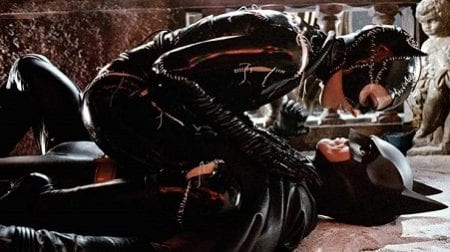Blu-ray Review: The Batman Four Film Collection 4K UHD

Meow.
Believe it or not, there was a time when multiple superhero movies weren’t released every year covering nearly every comic book character you could think of. In fact, outside of a few Superman movies it was barren for most of the 1980s. Into that void stepped director Tim Burton and Michael Keaton, fresh off the odd comedy Beetlejuice, along with Jack Nicholson to bring Batman to the big screen… and in many ways that set the stage for the current cinematic landscape.
Batman (1989)
With excellent performances by Keaton and Nicholson, Batman is far and away the best of the four films from this continuity. Obviously having the Batman and Joker rivalry puts the comic’s strongest feud to work, but it’s more than that. Everything feels fresh, and Burton’s direction and eye for bringing a dark vision of Gotham to life strike the right balance between serious and fun.
While Heath Ledger‘s portrayal of The Joker won critical praise and now stands atop the mountain for many, it’s worth revisiting just how good Nicholson’s was. He doesn’t carry quite the legitimate menace of Ledger, who made the character more of a sociopath than a “super villain,” but Nicholson brings a manic energy as he mixes funny moments alongside Joker’s penchant for mass murder. Kim Basinger also does good work as Vicki Vale, the love interest of both characters.
Batman Returns (1992)
Coming off the massive commercial success of the original, Keaton and Burton teamed up once again for Batman Returns. With Joker killed at the end of the first film, The Penguin (Danny DeVito) steps into the mantle of villain. Catwoman (Michelle Pfeiffer) also makes her debut as a “tweener,” opposing certain elements of evil but stopping well short of supporting the Caped Crusader.
It’s a solid film, still benefiting from Keaton’s work as Batman as well as Burton’s eye for bringing that dark and brooding atmosphere to life. There’s no question it misses Nicholson, however, as DeVito’s grotesque portrayal of Penguin just isn’t as entertaining — it’s telling that all three sequels featured multiple villains. Pfeiffer is stunning as Catwoman and was doubtless the object of countless fantasies among pubescent boys all around the world.
Batman Forever (1995)
Although it’s considered part of the same continuity as its two predecessors, Forever has an almost entirely different cast (outside of Michael Gough, who returns as Alfred) with post-Tombstone Val Kilmer taking over the lead and Burton stepping aside for Joel Schumacher (The Lost Boys, Flatliners). There’s plenty of star power involved, with Two-Face (Tommy Lee Jones) and The Riddler (Jim Carrey) serving as the dual villains, and Robin (Chris O’Donnell) arriving to aid Batman in his fight against crime.
Things really start to take a downward turn for the franchise here. Kilmer doesn’t bring the same depth to the title role that Keaton did, and Nicole Kidman feels shoehorned in under the credo of “Batman must have a love interest.” It’s also decidedly more family friendly than the previous films, making it feel like a summer popcorn flick instead of the continued story of one of the darkest heroes in comic history. Oh, and no Burton meant no Danny Elfman, which was another notable loss.
Batman & Robin (1997)
Schumaker and O’Donnell returned for the fourth film, but it was one and done for Kilmer, who was replaced by George Clooney when he was just starting to hit it big beyond ER. On paper, this might be the most loaded the cast ever was, especially when you consider what Clooney would become, with Arnold Schwarzenegger, Uma Thurman and Alicia Silverstone (at the height of her popularity) joining up. Unfortunately, it didn’t add up to a good movie, with Batman & Robin easily the worst of the four.
We noted that Forever took things in a family-friendly direction, but this one feels more like a live-action cartoon with its snarky dialogue and goofy aesthetic — not coincidentally, this is the only film that has no involvement from Burton, who was a producer on Forever. After watching it you’ll have no trouble figuring out why it bombed at theatres and why audiences wouldn’t get another Batman film until Christopher Nolan‘s Batman Begins almost a decade later.
THE 4K UHD UPGRADE
One of the best things that the UHD treatment does for the early Batman films is add clarity to all of the dark and gloomy settings. The increase in detail is excellent, and there isn’t much grain to be found, which is an impressive feat given the age of these movies. Colours also pop, something that’s particularly noticeable with the outfits for villains like Joker and Riddler — and yes, the Catwoman suit pops, too. The audio mix sounds first-rate, especially in the earlier films in which Elfman’s score blares through the speakers.
OVERALL
As a package, we’re looking at something of a split decision. Batman and Batman Returns are strong recommendations, whether you own them on Blu-ray or haven’t really experienced the franchise outside of Nolan’s vision. The movies hold up better than you might think, and the presentation upgrades afforded by the 4K UHD treatment are substantial.
Things get trickier with the other two films, particularly Batman & Robin, which simply isn’t a good movie. If you’re a massive Batman fan and/or a completionist and want to have the entire collection in 4K UHD, then go for it. Otherwise, we’d recommend just nabbing the Burton/Keaton entries and then pick back up with Nolan’s trilogy.







